Ebola virus sequesters IRF3 in viral inclusion bodies to evade host antiviral immunity
- PMID: 38285487
- PMCID: PMC10945704
- DOI: 10.7554/eLife.88122
Ebola virus sequesters IRF3 in viral inclusion bodies to evade host antiviral immunity
Abstract
Viral inclusion bodies (IBs) commonly form during the replication of Ebola virus (EBOV) in infected cells, but their role in viral immune evasion has rarely been explored. Here, we found that interferon regulatory factor 3 (IRF3), but not TANK-binding kinase 1 (TBK1) or IκB kinase epsilon (IKKε), was recruited and sequestered in viral IBs when the cells were infected by EBOV transcription- and replication-competent virus-like particles (trVLPs). Nucleoprotein/virion protein 35 (VP35)-induced IBs formation was critical for IRF3 recruitment and sequestration, probably through interaction with STING. Consequently, the association of TBK1 and IRF3, which plays a vital role in type I interferon (IFN-I) induction, was blocked by EBOV trVLPs infection. Additionally, IRF3 phosphorylation and nuclear translocation induced by Sendai virus or poly(I:C) stimulation were suppressed by EBOV trVLPs. Furthermore, downregulation of STING significantly attenuated VP35-induced IRF3 accumulation in IBs. Coexpression of the viral proteins by which IB-like structures formed was much more potent in antagonizing IFN-I than expression of the IFN-I antagonist VP35 alone. These results suggested a novel immune evasion mechanism by which EBOV evades host innate immunity.
Keywords: Ebola virus; VP24; VP35; immunology; infectious disease; inflammation; microbiology; virus inclusion bodies; virus infection; viruses.
© 2023, Zhu et al.
Conflict of interest statement
LZ, JJ, TW, YH, HL, TG, QD, YJ, PL, ZL, YH, XL, CC No competing interests declared
Figures



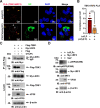




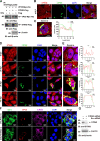
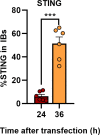
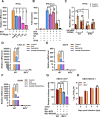

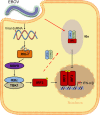
Update of
- doi: 10.1101/2023.04.20.537734
- doi: 10.7554/eLife.88122.1
- doi: 10.7554/eLife.88122.2
Similar articles
-
Ebola Virus Inclusion Body Formation and RNA Synthesis Are Controlled by a Novel Domain of Nucleoprotein Interacting with VP35.J Virol. 2020 Jul 30;94(16):e02100-19. doi: 10.1128/JVI.02100-19. Print 2020 Jul 30. J Virol. 2020. PMID: 32493824 Free PMC article.
-
Evasion of antiviral immunity through sequestering of TBK1/IKKε/IRF3 into viral inclusion bodies.J Virol. 2014 Mar;88(6):3067-76. doi: 10.1128/JVI.03510-13. Epub 2013 Dec 11. J Virol. 2014. PMID: 24335286 Free PMC article.
-
Impact of Měnglà Virus Proteins on Human and Bat Innate Immune Pathways.J Virol. 2020 Jun 16;94(13):e00191-20. doi: 10.1128/JVI.00191-20. Print 2020 Jun 16. J Virol. 2020. PMID: 32295912 Free PMC article.
-
Evasion of interferon responses by Ebola and Marburg viruses.J Interferon Cytokine Res. 2009 Sep;29(9):511-20. doi: 10.1089/jir.2009.0076. J Interferon Cytokine Res. 2009. PMID: 19694547 Free PMC article. Review.
-
Insights into Ebola Virus VP35 and VP24 Interferon Inhibitory Functions and their Initial Exploitation as Drug Targets.Infect Disord Drug Targets. 2019;19(4):362-374. doi: 10.2174/1871526519666181123145540. Infect Disord Drug Targets. 2019. PMID: 30468131 Review.
Cited by
-
Participation of host cell proteins in inclusion bodies of non-segmented RNA virus infected cells: a molecular insight.Virol J. 2025 Aug 18;22(1):282. doi: 10.1186/s12985-025-02784-w. Virol J. 2025. PMID: 40826091 Free PMC article. Review.
-
Antiviral defense against filovirus infections: targets and evasion mechanisms.Future Microbiol. 2025 May-Jun;20(7-9):573-587. doi: 10.1080/17460913.2025.2501924. Epub 2025 May 7. Future Microbiol. 2025. PMID: 40331244 Free PMC article. Review.
-
Negative and ambisense RNA virus ribonucleocapsids: more than protective armor.Microbiol Mol Biol Rev. 2023 Dec 20;87(4):e0008223. doi: 10.1128/mmbr.00082-23. Epub 2023 Sep 26. Microbiol Mol Biol Rev. 2023. PMID: 37750733 Free PMC article. Review.
-
Grass carp Trim47 restricts GCRV infection via SPRY domain-mediated autophagic degradation of nonstructural proteins and disruption of viral inclusion bodies.Front Immunol. 2025 Jul 10;16:1623014. doi: 10.3389/fimmu.2025.1623014. eCollection 2025. Front Immunol. 2025. PMID: 40709172 Free PMC article.
-
Severe long-term clinical sequelae among Sudan ebolavirus disease survivors 2 years post-infection.Res Sq [Preprint]. 2025 Apr 17:rs.3.rs-6325522. doi: 10.21203/rs.3.rs-6325522/v1. Res Sq. 2025. Update in: BMC Med. 2025 Jul 18;23(1):432. doi: 10.1186/s12916-025-04271-z. PMID: 40321748 Free PMC article. Updated. Preprint.
References
MeSH terms
Substances
Grants and funding
- 82372255/National Natural Science Foundation of China
- 2022ACCP-MS04/Advanced Customer Cultivation Project of the Wuhan National Biosafety Laboratory, the Chinese Academy of Sciences
- 2018ZX09711003-005-005/National Major Science and Technology Projects of China
- 2022YFC2600704/National Major Science and Technology Projects of China
LinkOut - more resources
Full Text Sources
Medical
Research Materials
Miscellaneous

